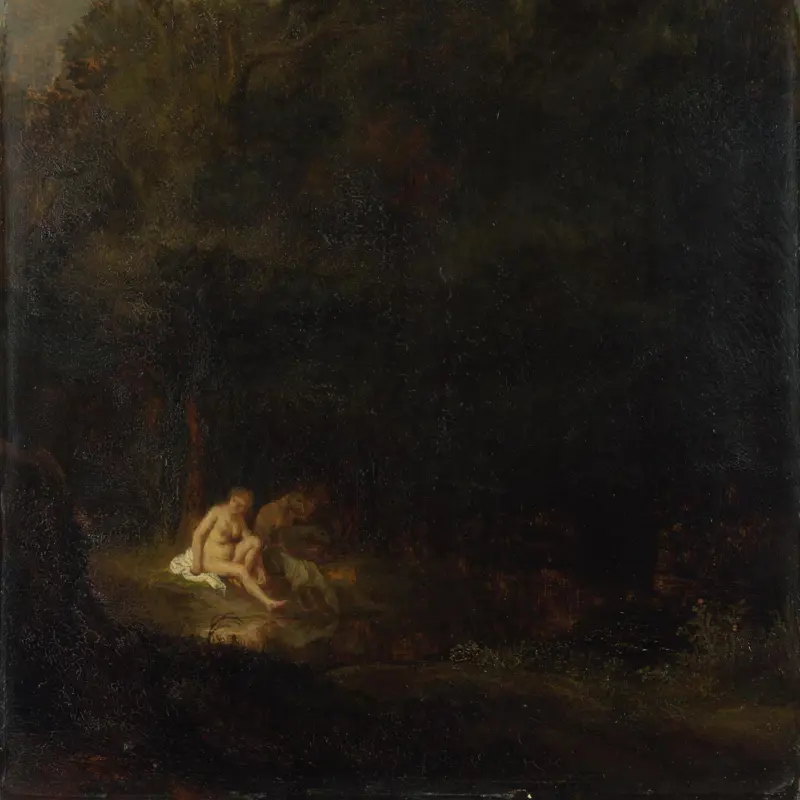Rembrandt, 'The Lamentation over the Dead Christ', about 1635
About the work
Overview
Christ’s body has just been taken down from the Cross, and his family and followers mourn over him – a moment known as The Lamentation. Rembrandt laboured over this small monochrome picture. He began by making an oil sketch on paper, then tore out a section and mounted the rest on canvas. He continued the design on the canvas at the lower right, before someone else extended the picture by adding strips to the top and bottom.
The picture is very likely a study for an etching that Rembrandt never executed. One of the clues for this is in the positioning of the two men who were crucified alongside Christ, the so-called Good Thief and Bad Thief. Here, the Bad Thief appears to Christ’s right, which was traditionally the position reserved for the Good Thief. In the making of an etching, however, the whole composition would be reversed.
Key facts
Details
- Full title
- The Lamentation over the Dead Christ
- Artist
- Rembrandt
- Artist dates
- 1606 - 1669
- Date made
- about 1635
- Medium and support
- oil on paper and pieces of canvas, mounted on wood
- Dimensions
- 31.9 × 26.7 cm
- Acquisition credit
- Presented by Sir George Beaumont, 1823/8
- Inventory number
- NG43
- Location
- Room 22
- Collection
- Main Collection
- Previous owners
Provenance
Additional information
Text extracted from the ‘Provenance’ section of the catalogue entry in Neil MacLaren, revised and expanded by Christopher Brown, ‘National Gallery Catalogues: The Dutch School: 1600–1900’, London 1991; for further information, see the full catalogue entry.
Exhibition history
-
2008Rembrandt. History PainterMuseo Nacional del Prado15 October 2008 - 6 January 2009
-
2012Rembrandt and the Passion (Hunterian)Hunterian Museum15 September 2012 - 2 December 2012
-
2016Painters' Paintings: From Freud to Van DyckThe National Gallery (London)23 June 2016 - 4 September 2016
-
2017Monochrome: Painting in Black and White.Museum Kunstpalast22 March 2018 - 15 July 2018
-
2018Rembrandt: Britain's Discovery of the MasterScottish National Gallery7 July 2018 - 14 October 2018
Bibliography
-
1795Christie, Manson & Woods, A Catalogue of the Capital, Genuine and Valuable Collection of Pictures, late the Property of… Sir Joshua Reynolds, London, 11 March 1795 - 14 March 1795
-
1829
J. Smith, A Catalogue Raisonné of the Works of the Most Eminent Dutch, Flemish, and French Painters: In Which is Included a Short Biographical Notice of the Artists, with a Copious Description of Their Principal Pictures […], 9 vols, London 1829-1842
-
1897W. von Bode and C. Hofstede de Groot, The Complete Work of Rembrandt, 8 vols, Paris 1897
-
1909A. Rosenberg and W.R. Valentiner, Rembrandt: Des Meisters Gemalde mit einer biographischen Einleitung, Stuttgart 1909
-
1929W. Stechow, 'Rembrandts Darstellungen der Kreuzabnahme', Jahrbuch der Königlich Preussischen Kunstsammlungen, L, 1929, pp. 217-32
-
1935O. Benesch, Rembrandt: Werk und Forschung, Vienna 1935
-
1945'Editorial: Sir Joshua Reynolds' Collection of Pictures, III', The Burlington Magazine, LXXXVII/512, 1945, pp. 263-73
-
1960Maclaren, Neil, National Gallery Catalogues: The Dutch School, 2 vols, London 1960
-
1967F.W. Robinson, 'Rembrandt's Influence in 18th Century Venice', Nederlands Kunsthistorisch Jaarboek, XVIII, 1967, pp. 167-96
-
1969A. Harris, 'Rembrandt's Study for "The Lamentation for Christ"', Master Drawings, VII/2, 1969, pp. 158-64
-
1973J.G. van Gelder, 'Frühe Rembrandt-Sammlungen', in O. von Simson and J. Kelch (eds), Neue Beiträge zur Rembrandt-Forschung, Berlin 1973, pp. 189-206
-
1982C. Brown, Rembrandt, London 1982
-
1984G. Schwartz, Rembrandt: Zijn leven, zijn schilderijen: Een nieuwe biografie met alle beschikbare schilderijen in klur afgebeeld, Maarssen 1984
-
1988National Gallery, 'Pictures Cleaned and Restored in the Conservation Department of the National Gallery, 1987', National Gallery Technical Bulletin, XII, 1988
-
1988D. Bomford et al., Rembrandt (exh. cat. The National Gallery, 12 October 1988 - 17 January 1989), London 1988
-
1989J. Mills and R. White, 'Paint Media Analyses', National Gallery Technical Bulletin, XIII, 1989, pp. 69-71
-
1989M. Royalton-Kisch, 'Rembrandt's Sketches for His Paintings', Master Drawings, XXVII/2, 1989, pp. 128-45
-
1991Maclaren, Neil, revised by Christopher Brown, National Gallery Catalogues: The Dutch School, 1600-1900, 2nd edn (revised and expanded), 2 vols, London 1991
-
1993C. Tümpel, Rembrandt: All Paintings in Colour, Antwerp 1993
-
1995C. Wiggins, Frank Auerbach and the National Gallery: Working after the Masters (exh. cat. The National Gallery, London, 19 July - 17 September 1995), London 1995
-
2001
C. Baker and T. Henry, The National Gallery: Complete Illustrated Catalogue, London 2001
-
2003C.S. Ackley et al., Rembrandt's Journey: Painter, Draftsman, Etcher (exh. cat. Museum of Fine Arts, 26 October 2003 - 18 January 2004; Art Institute of Chicago, 14 February - 9 May 2004), Boston 2003
-
2006D. Bomford et al., Rembrandt, London 2006
About this record
If you know more about this work or have spotted an error, please contact us. Please note that exhibition histories are listed from 2009 onwards. Bibliographies may not be complete; more comprehensive information is available in the National Gallery Library.


























